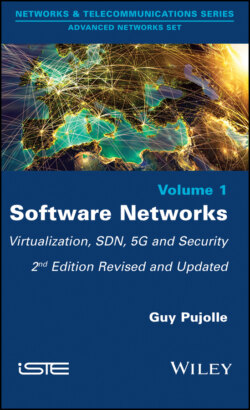Читать книгу Software Networks - Guy Pujolle - Страница 17
1.1. Software networks
ОглавлениеVirtual machines, in turn, can be used to create virtual networks, which are also known as software networks. For this purpose, we need to link virtual machines together in the same way as we would connect different physical machines. Of course, the communication links must be shared between the different software networks. A set of software networks are represented in Figure 1.3.
Figure 1.3. A set of software networks. For a color version of the figure, see www.iste.co.uk/pujolle/software2.zip
Each software network may have its own architecture and its own characteristics. One software network could be devoted to a VoIP service, another to an IPTV service, a third to a highly secure application, a fourth to support professional applications, a fifth for asynchronous applications such as electronic messaging, etc. We could, in fact, practically create a software network for each user. The personalized software network is set up at the moment when the user connects. It is eliminated when the user signs out. However, this solution does not scale up, and today, we are limited to a number of software networks suited to the hardware capacity of the underlying physical infrastructure. Each software network receives resources allocated to it on the basis of the user demands. However, resources remain shared by different techniques that allow virtual networks to recover resources from other unused virtual networks.
It should be noted that, in general, the virtual nodes are found in datacenters, which may be of varying size and importance: enormous central datacenters, regional datacenters, local datacenters and small datacenters such as femto-datacenters. We will come back later on to the choices which may be made in this field.
One of the characteristics of software networks is that the virtual machines can be migrated from one physical machine to another. This migration may be automated based on whether a node is overloaded or out of order.
In the physical nodes that support the software networks, we can add other types of virtual machines such as firewalls, SIP servers for VoIP, middle boxes, etc. The networks themselves, as stated above, may obey a variety of different protocol architectures such as TCP/IPv4, UDP/IPv4, IPv6, MPLS, Ethernet Carrier Grade, TRILL, LISP, etc.
Isolation is, of course, a crucial property, because it is essential to prevent a problem on one software network from having repercussions for the other networks. The handover of streams from one software network to another must take place via a secure gateway outside of the data plane. This is absolutely necessary to prevent contamination between networks, such as a complete shutdown for a network attacked, for example, by a distributed denial of service (DDOS).
